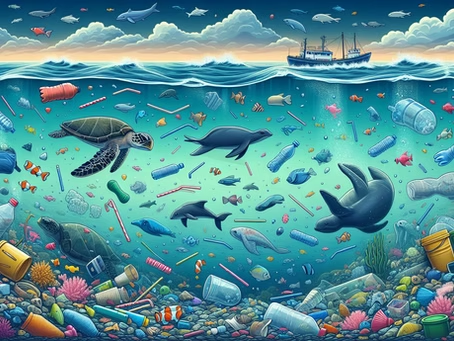The Devastating Impact of Plastic Pollution on Marine Life
Plastic pollution has become one of the most severe environmental crises facing our oceans, with devastating consequences for marine ecosystems and the countless species that inhabit them. From microscopic plankton to the largest whales, no marine organism remains untouched by the pervasive presence of plastic waste. This pollution manifests through entanglement, ingestion, habitat destruction, and toxic contamination, creating a multi-faceted threat that undermines the health and resilience of marine environments worldwide. The scale of this problem demands immediate and comprehensive action to address both the sources of plastic pollution and its impacts on ocean life.
Understanding the Scale of Marine Plastic Pollution
Plastic pollution in marine environments has reached staggering proportions with far-reaching implications.
Global Statistics and Distribution
Current estimates reveal the overwhelming scale of the problem:
• 8 million metric tons of plastic enter oceans annually
• 5.25 trillion plastic particles currently circulating in marine environments
• 88% of ocean surface waters show plastic contamination
• Plastic debris found from Arctic sea ice to deepest ocean trenches
Pathways to Marine Environments
Plastic reaches oceans through multiple routes:
• River systems: Major rivers transport plastic from inland areas
• Coastal littering: Direct disposal along shorelines and beaches
• Fishing activities: Lost or abandoned fishing gear
• Atmospheric transport: Microplastics carried by wind and precipitation
• Wastewater systems: Microfibers from synthetic clothing
Persistence and Accumulation
Plastic pollution characteristics:
• Extreme durability: Most plastics persist for centuries
• Bioaccumulation: Concentration increases through food webs
• Global circulation: Ocean currents concentrate plastics in gyres
• Continuous fragmentation: Breaking into smaller particles over time
Direct Impacts on Marine Organisms
Plastic pollution affects marine life through multiple mechanisms of harm.
Entanglement and Physical Harm
Marine animals become trapped in plastic debris:
• Fishing gear: Nets, lines, and traps cause “ghost fishing”
• Packaging materials: Six-pack rings, plastic bands
• Abandoned gear: Lost fishing equipment continues catching animals
• Consequences: Injuries, drowning, starvation, reduced mobility
Ingestion and Digestive Blockages
Animals mistakenly consume plastic debris:
• Visual confusion: Plastic resembles natural prey items
• Chemical attraction: Biofouling creates food-like odors
• Filter feeding: Microplastics consumed with plankton
• Impacts: Internal injuries, false satiation, starvation
Species Most Affected
Vulnerable marine organisms include:
• Marine mammals: Seals, whales, dolphins
• Sea turtles: All seven species affected
• Seabirds: Particularly albatross and shearwaters
• Fish species: Over 100 species documented with plastic ingestion
Microplastics: The Invisible Threat
Microscopic plastic particles present unique challenges to marine ecosystems.
Formation and Sources
Microplastics originate from various sources:
• Primary microplastics: Intentionally manufactured small particles
• Secondary microplastics: Breakdown of larger plastic items
• Microfibers: Synthetic textiles shedding during washing
• Tire wear: Vehicle tires releasing synthetic particles
Ecological Impacts
Microplastics affect marine ecosystems through:
• Bioaccumulation: Concentration in food webs
• Trophic transfer: Movement between predator and prey
• Habitat contamination: Settlement on seafloor and coral reefs
• Filter feeder exposure: High concentrations in bivalves and other filter feeders
Physiological Effects
Microplastics cause sublethal impacts:
• Inflammation: Tissue damage from particle accumulation
• Reduced feeding: False satiation and energy depletion
• Reproductive effects: Impacts on fertility and offspring viability
• Oxidative stress: Cellular damage from plastic additives
Chemical Contamination and Toxic Effects
Plastics introduce and concentrate harmful chemicals in marine environments.
Plastic Additives and Leachates
Plastics contain numerous chemical additives:
• Plasticizers: Phthalates used to increase flexibility
• Flame retardants: Brominated compounds added for safety
• Stabilizers: UV inhibitors and antioxidants
• Colorants: Various pigments and dyes
Pollutant Adsorption and Transport
Plastics concentrate environmental contaminants:
• Hydrophobic compounds: PCBs, PAHs, DDT adhere to plastics
• Concentration effect: Plastics can concentrate pollutants up to 1 million times
• Vector effect: Transport contaminants to new areas
• Bioavailability: Enhanced transfer to marine organisms
Endocrine Disruption
Plastic-associated chemicals affect hormonal systems:
• Bisphenol A (BPA): Mimics estrogen and disrupts reproduction
• Phthalates: Interfere with testosterone and development
• Alkylphenols: Surfactant breakdown products with estrogenic effects
• Physiological impacts: Altered development, reproduction, and behavior
Ecosystem-Level Consequences
Plastic pollution affects entire marine ecosystems and their functioning.
Habitat Destruction and Alteration
Plastic debris modifies marine habitats:
• Coral reef damage: Physical abrasion and disease transmission
• Seagrass smothering: Light reduction and physical pressure
• Sediment alteration: Changes to seafloor composition and chemistry
• Oxygen depletion: Microbial decomposition consumes oxygen
Community Structure Changes
Plastic affects species composition and interactions:
• Invasive species transport: Rafting on floating debris
• Competitive advantage: Some species adapt to use plastic
• Predator-prey relationships: Altered interactions due to plastic impacts
• Biodiversity loss: Sensitive species decline while tolerant ones persist
Ecosystem Service Impacts
Plastic pollution affects valuable ecosystem services:
• Fisheries decline: Reduced catches and contaminated seafood
• Tourism impacts: Aesthetic degradation of coastal areas
• Carbon cycling: Potential effects on biological pump efficiency
• Coastal protection: Damage to protective habitats like mangroves
Conservation and Mitigation Strategies
Addressing plastic pollution requires comprehensive approaches at multiple levels.
Policy and Regulatory Measures
Government actions to reduce plastic pollution:
• Single-use plastic bans: Restrictions on problematic items
• Extended producer responsibility: Manufacturer accountability for waste
• International agreements: Global coordination on plastic waste
• Fishing gear management: Reducing abandoned, lost, or discarded gear
Innovative Technologies
Technical solutions for addressing plastic pollution:
• Capture devices: River and ocean-based collection systems
• Biodegradable alternatives: Developing compostable materials
• Recycling advances: Improved processing and upcycling
• Monitoring systems: Remote sensing and AI for tracking plastic
Community and Individual Actions
Grassroots efforts to reduce plastic pollution:
• Beach cleanups: Removing debris from coastal areas
• Consumer choices: Selecting plastic-free alternatives
• Education programs: Raising awareness about impacts
• Citizen science: Participating in monitoring and research
Research Priorities and Knowledge Gaps
Critical areas requiring further scientific investigation.
Ecological Risk Assessment
Understanding thresholds and impacts:
• Dose-response relationships: Quantifying effects across species
• Ecosystem thresholds: Identifying tipping points for damage
• Long-term monitoring: Tracking changes over time
• Cumulative impacts: Interactions with other stressors
Fate and Transport Mechanisms
Studying plastic movement and transformation:
• Vertical transport: Sinking processes and deep-sea accumulation
• Biological transport: Movement through migratory species
• Fragmentation rates: Environmental breakdown processes
• Hotspot identification: Areas of particular concern
Solution Development
Research supporting mitigation efforts:
• Alternative materials: Developing sustainable substitutes
• Removal strategies: Effective cleanup approaches
• Policy effectiveness: Evaluating intervention success
• Circular economy: Designing out plastic waste

